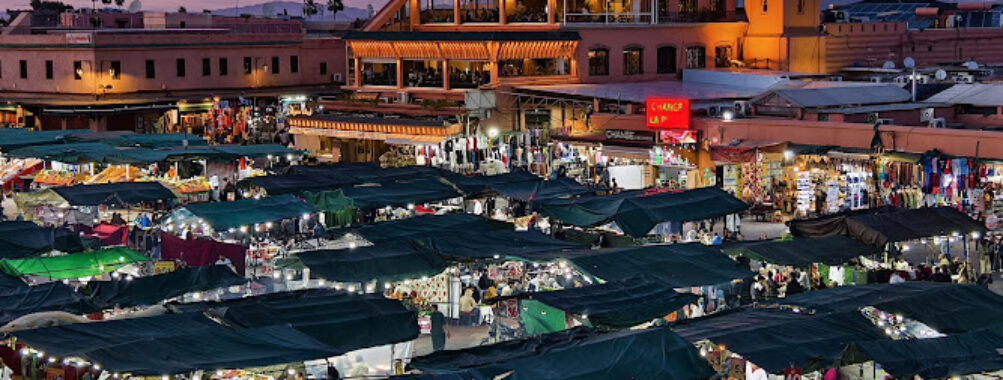
Jemaa el-Fnaa
Table of Contents
Description
Jemaa el-Fnaa is the kind of place that feels like it has a pulse of its own. Right in the heart of Marrakesh, this square has been a meeting point for centuries, and you can still sense that history in the air. On any given day, you’ll see an unusual mix of sights and sounds: orange juice vendors shouting out their prices, snake charmers playing their flutes, storytellers gathering curious crowds, and food stalls firing up sizzling grills. It’s chaotic, yes, but in that beautiful way where you feel like you’re standing in the middle of something much bigger than yourself.
Not everyone falls in love with it at first sight. Some travelers find it overwhelming—the noise, the crowds, the constant movement. Others, though, find themselves returning night after night, drawn in by the energy and the sense that anything could happen here. Personally, I think both reactions are valid. It’s not a polished tourist attraction; it’s raw, it’s messy, and at times it can even feel a little too much. But that’s exactly what makes it unforgettable. You don’t come to Jemaa el-Fnaa for perfection—you come for the stories you’ll tell afterward.
What makes this square stand out is its ability to transform throughout the day. In the morning, it’s calmer, with fruit stands and herbalists taking center stage. By late afternoon, the performers roll in, and by nightfall, the entire square turns into one massive open-air restaurant under the stars. If you’ve ever wanted to see a city’s culture condensed into one place, this is it.
Key Features
- Street food stalls offering everything from grilled meats to traditional Moroccan soups
- Entertainers including snake charmers, acrobats, and musicians
- Storytellers and fortune tellers keeping centuries-old traditions alive
- Market stalls selling spices, dried fruits, souvenirs, and herbal remedies
- UNESCO-recognized cultural space with deep historical roots
- Accessible entrances and parking for visitors with mobility needs
- Free parking lot nearby for those arriving by car
Best Time to Visit
If you ask me, the magic really happens after sunset. As the sky darkens and the lanterns light up, the square becomes a completely different world. The air fills with the aroma of grilled kebabs and spiced tagines, and suddenly there’s music coming from every corner. It’s a sensory overload in the best possible way. That being said, mornings are great if you want a quieter experience and a chance to actually look around without being swept up in the crowd.
Spring and autumn are the sweet spots weather-wise. Marrakesh summers can be scorching, and while the square still comes alive, you’ll probably want to avoid standing around in the midday sun. Winter evenings can be chilly, so bring a jacket if you plan to linger after dark. And honestly, don’t be afraid to visit more than once—seeing Jemaa el-Fnaa at different times of day gives you a fuller picture of what it’s really about.
How to Get There
Since Jemaa el-Fnaa sits at the heart of Marrakesh, you’ll probably find yourself passing through it whether you plan to or not. Most travelers arrive on foot, especially if they’re staying in the medina. Walking through the narrow alleyways that suddenly open up into the wide expanse of the square is an experience in itself—it almost feels like stepping onto a stage.
If you’re coming from further out, taxis are easy to find, though be prepared to negotiate the fare. There’s also free parking nearby if you’re driving, but navigating Marrakesh traffic isn’t for the faint of heart. Personally, I’d recommend walking whenever possible; it’s the best way to soak in the atmosphere of the old city and stumble upon little hidden gems along the way.
Tips for Visiting
Visiting Jemaa el-Fnaa is exciting, but it’s also a bit of an adventure, so a few practical tips go a long way. First, keep an open mind and a sense of humor. You will be approached by performers, henna artists, and vendors, and sometimes it can feel a bit intense. A polite “no, thank you” usually does the trick, but if you’re interested, don’t be afraid to engage—it’s part of the experience.
Second, bring small change. Whether you’re buying fresh orange juice or tipping a musician, having coins handy makes everything smoother. And about the food stalls: they’re fantastic, but don’t just pick the first one you see. Take a lap around the square, see what looks (and smells) best, and then dive in. I still remember the first time I tried harira soup here—it was from a stall recommended by a local, and it ended up being one of the most memorable meals of my trip.
Safety-wise, the square is generally fine, but like any crowded place, keep an eye on your belongings. Pickpocketing does happen. Also, if you want to take photos of performers, it’s expected that you tip them. It’s their livelihood, after all. And here’s a little personal tip: don’t rush. Sit down at a rooftop café overlooking the square, order a mint tea, and just watch. Sometimes the best way to experience Jemaa el-Fnaa is from above, where you can take in the whole scene at once without being in the middle of the chaos.
Finally, be ready for mixed feelings. Some people absolutely adore the square, others find it overwhelming, and many fall somewhere in between. That’s okay. What matters is that you give yourself the chance to experience it fully, because whether you love it or not, Jemaa el-Fnaa is one of those places that sticks with you long after you’ve left Marrakesh.
Location
Places to Stay Near Jemaa el-Fnaa
Find and Book a Tour
Explore More Travel Guides
No reviews found! Be the first to review!